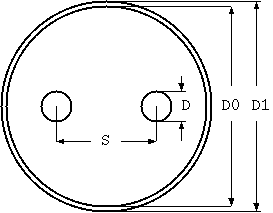

If conductor shield inner diameter is set larger enough or set to zero, it will be in the case of unshielded. If conductivity and permeability is set to zero, shield is assumed to be the same material as the conductor material.

If thickness is set to zero or half diameter, this will be the solid case.
If we want to calculate the AC resistance and inductance of multi-core cable,
Surrounding conductors increase AC resistance and decrease inductance.
The first calculation is based on
V.Belevitch,- Theory of Proximity Effect in Multiwair Cables (Philips Res. Repts, 32, 16-43/96-117, 1977)
The second calculation is based on
A.H.M.Arnold,- Proximity Effect in Solid and Hollow Round Conductors (Jour. I.E.E. vol 88, Part 2, 349-359, 1941)
In addition, the permeability of the air is 4e-7 * π (H / m), and condctivity of copper is 5.8e7 (G / m)
1999-04-20, Kouichi Hirabayashi